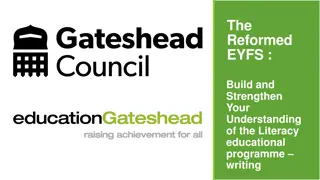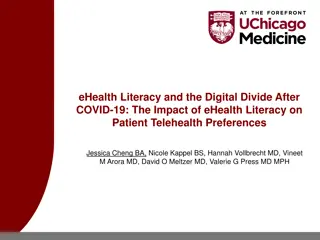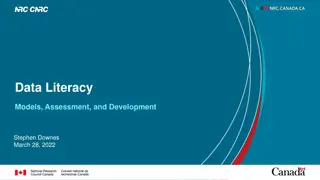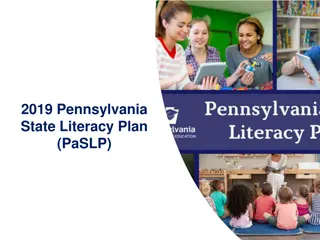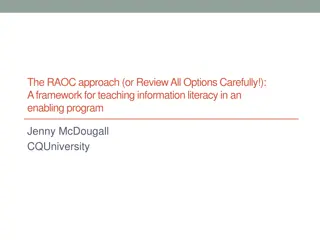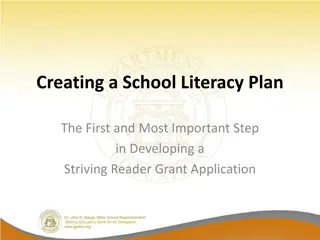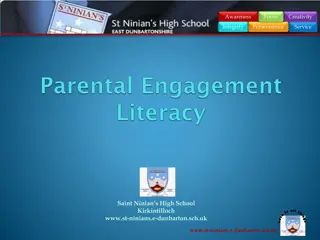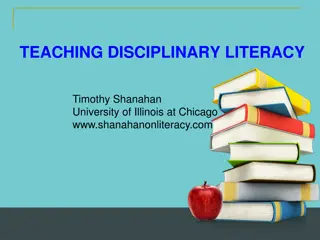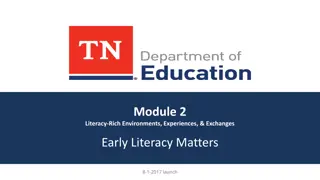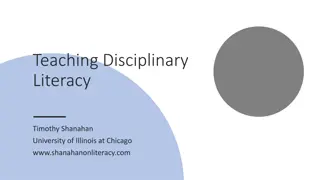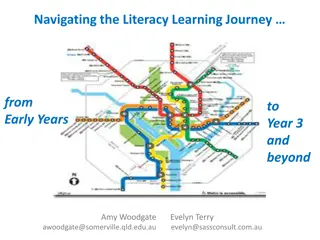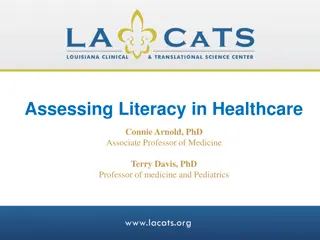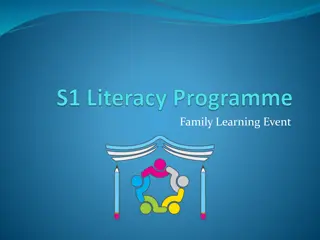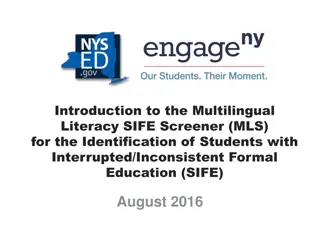Understanding Information Literacy: A Comprehensive Guide for Students
Information literacy is crucial for academic success. It involves the ability to recognize the need for information, locate relevant sources, evaluate their credibility, and effectively use the information for research and presentations. Primary and secondary sources play a vital role in gathering information, with primary sources providing firsthand accounts of events and secondary sources offering analysis and interpretation. The importance of web resources credibility is highlighted through the CRAAP Test, a set of criteria to evaluate online information sources.
Download Presentation

Please find below an Image/Link to download the presentation.
The content on the website is provided AS IS for your information and personal use only. It may not be sold, licensed, or shared on other websites without obtaining consent from the author. Download presentation by click this link. If you encounter any issues during the download, it is possible that the publisher has removed the file from their server.
E N D
Presentation Transcript
Information Literacy New Student Orientation August 2018 L. Douglas Wilder Library
What is Information Literacy? Information literacy is the ability to know that you need information and then how to locate, evaluate and effectively use the information in whatever manner you choose, i.e. research papers, presentations, etc.
Information Literacy RESOURCES
Primary & Secondary Sources A Primary Source is an original resource that accounts first-hand the events of a specific time and place. These sources were present during an experience or time period and offer and inside view of a particular event.
Primary & Secondary Sources A Secondary Source analyzes and interprets primary sources. These sources are one or more steps removed from the event.
Primary & Secondary Sources Primary Source examples: Diaries, letters, speeches, manuscripts, interviews, newspaper articles (factual accounts), government records, songs, plays, paintings and sculpture. Secondary Source examples: Textbooks, histories, criticisms, biographies, book reviews, encyclopedias, and newspaper and magazine articles that interpret.
Primary & Secondary Sources Primary Source Specific Examples Martin Luther King Jr. s I Have a Dream speech. U.S. Census Records & Statistics Anne Frank: the diary of a young girl Beak Style Mask from New Guinea at the VUU Art Museum Secondary Sources Specific Examples Book: I have a dream: Martin Luther King Jr. and the future of multicultural America by James Echols. Book: The new race question: how the census counts multiracial individuals by Joel Perlmann Journal Article: The nation behind the diary: Anne Frank and the Holocaust of the Dutch Jews by Jennifer Foray. Journal Article: Primitivism and Postcolonialism in the Arts by Jean- Loup Amselle, et.al.
Web Resources It is often difficult to know if a website is a credible & effective source for your work. The CRAAP Test is a list of questions to help you evaluate the information you find. Different criteria will be more or less important depending on your situation or need.
CRAAP TEST - Evaluation Criteria Currency: The timeliness of the information. When was the information published or posted? Has the information been revised or updated? Does your topic require current information, or will older sources work as well? Are the links functional? Relevance: The importance of the information for your needs. Does the information relate to your topic or answer your question? Who is the intended audience? Is the information at an appropriate level (i.e. not too elementary or advanced for your needs)? Have you looked at a variety of sources before determining this is one you will use? Would you be comfortable citing this source in your research paper?
CRAAP TEST - Evaluation Criteria Authority: The source of the information. Who is the author/publisher/source/sponsor? What are the author's credentials or organizational affiliations? Is the author qualified to write on the topic? Is there contact information, such as a publisher or email address? Does the URL reveal anything about the author or source? examples: .com .edu .gov .org .net Accuracy: The reliability, truthfulness and correctness of the content. Where does the information come from? Is the information supported by evidence? Has the information been reviewed or refereed? Can you verify any of the information in another source or from personal knowledge? Does the language or tone seem unbiased and free of emotion? Are there spelling, grammar or typographical errors?
CRAAP TEST - Evaluation Criteria Purpose: The reason the information exists. What is the purpose of the information? Is it to inform, teach, sell, entertain or persuade? Do the authors/sponsors make their intentions or purpose clear? information fact, opinion or propaganda? Does the point of view appear objective and impartial? Are there political, ideological, cultural, religious, institutional or personal biases? Is the
Citations Why do we have citations? We think the following from theWilliam H. Hannon Library of the Loyola Marymount University answers this question perfectly: "Citations help others find the information you used in your research paper." "Citing your sources accurately helps establish the credibility of your research." "Citations connect your work to the work of other scholars." "Citations are one way to honor and acknowledge the work of others who have made your own research possible." Reference Department. "Citation Styles." LIbGuides. William H. Hannon Library, Loyola Marymount University, 21 Jan. 2014. Web. 06 Apr. 2014. http://libguides.lmu.edu/citations
Citations Plagiarism Plagiarism is taking someone else's work, words, or ideas and claiming them as your own original work. A paraphrase as well as a direct quote must have a citation. More information and help go to Plagiarism.org
Citations Citation Styles Different disciplines use different citation styles. MLA Citation Style was created and is maintained by Modern Language Association of America. It is mainly used for the humanities, i.e. English, Media Studies.
Citations Citation Styles APA Citation Style was created and is maintained by the American Psychological Association. It is mainly used in the social & behavioral sciences, i.e. Psychology, Political Science, Education. Turabian Citation Style was created by Kate Turabian in the book A Manual for Writers of Research Papers, Theses, and Dissertations . It is sometimes referred to has Chicago Style from the book The Chicago Manual of Style. It is mainly used in the humanities and is the style of the School of Theology.
Citations Citation Styles APA & MLA both use In-Text Citation when quoting or paraphrasing a source. Harlem had many artists and musicians in the late 1920s (Belafonte, 2008). All citations used in a paper are included in a list at the end. For APA it is titled References and for MLA it is titled Works Cited. o
Citations Citation Styles o Turabian/Chicago uses footnotes or endnotes when quoting or paraphrasing a source. All citations used in a paper are included in a list at the end entitled Bibliography. Mitchell, J. (2017). Bid them to come: Engaging black millennials in discipleship development (Order No. 10275596). Available from ProQuest Dissertations & Theses Global. (1896531150). Retrieved from https://search.proquest.com/docview/1 896531150?accountid=14855 o
Wilder Library Liaison Librarians Pearl Adzei-Stonnes, Acquisitions Librarian (804) 278-4112 pgadzei-stonnes@vuu.edu Education Philosophy Foreign Language Religious Studies (undergraduate) Theological (graduate) Pamela Foreman, Director (804) 257-5821 pforeman@vuu.edu Theological (graduate) Shanda Lemon, Public Services: Electronic Database Resources Librarian (804) 278-4120 slemon@vuu.edu Psychology Social Work Criminal Justice Mass Communication Theological (graduate) Sara Marrin, Technical Services Librarian (804) 257-5823 semarrin@vuu.edu History Business Political Science Music Fine Arts Theological (graduate) Selicia Allen, University Archivist/ Special Collections Librarian (804) 278-4117 sngregory@vuu.edu Natural Sciences Math English Theological (graduate)
Questions? Thank you.


